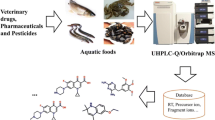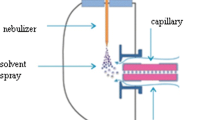Abstract
In this article, an accurate mass multiresidue screening method has been developed for the determination of over 630 multiclass food contaminants in different matrices using ultra-high performance liquid chromatography/(quadrupole)-time-of-flight mass spectrometry. The compounds included in the study were 426 pesticides, 117 veterinary drugs, 42 food-packaging contaminants, 21 mycotoxins, 10 perfluorinated compounds, 9 nitrosamines, and 5 sweeteners. The separation was carried out by liquid chromatography using a C18 column (50 mm × 2.1 mm, 1.8 μm particle size). The identification of the targeted species was accomplished using accurate masses of the targeted ions (protonated or deprotonated molecule) along with retention time data and characteristic fragment ion for reliable identification, using specific software for automated data mining and exploitation. The performance of the screening method was validated in terms of linearity, matrix effect, and limits of quantification for three representative food matrices (tomato, orange, and baby food) using a generic sample treatment based on liquid partitioning with acetonitrile (QuEChERS). The overall method performance was satisfactory with limits of quantification lower than 10 μg kg −1 for the 44 % of studied compounds. In some cases (ca. 10–15 % of the pesticides depending on the matrix tested, maximum residue levels were not fulfilled). In orange, 15 % of the compounds displayed LOQs above the maximum residue levels (MRLs) set for the studied pesticides, which can be partially attributed to matrix effects. Moderate signal suppression was observed in the three matrices tested in most cases, being orange the matrix which produced the highest matrix effect and baby food the lowest one.








Similar content being viewed by others
Abbreviations
- CCL-3:
-
Contaminant candidate lists
- CID:
-
Collision-induced dissociation
- GC-MS/MS:
-
Gas chromatography/tandem mass spectrometry
- HRMS:
-
High-resolution mass spectrometry
- LC-MS/MS:
-
Liquid chromatography/tandem mass spectrometry
- MeOH:
-
Methanol
- QC:
-
Quality control
- QuEChERS:
-
Quick, easy, cheap, effective, rugged, and safe
References
Alder L, Steinborn A, Bergelt S (2011) Suitability of an Orbitrap mass spectrometer for the screening of pesticide residues in extracts of fruits and vegetables. J AOAC Int 94:1661–1673
Canadian Food Inspection Agency (CFIA) (2016) Available on: http://www.inspection.gc.ca/
Codex Alimentarius (2016) Pesticide residues in food, maximum residue limits. Available on: http://www.fao.org/fao-who-codexalimentarius/standards/pestres/en/
Di Stefano V, Avellone G, Bongiorno D, Cunsolo V, Muccilli V, Sforza S, Dossena A, Drahos L, Vekey K (2012) Applications of liquid chromatography-mass spectrometry for food analysis. J Chromatogr A 1259:74–85
Díaz R, Ibañez M, Sancho JV, Hernández F (2011) Building an empirical mass spectra library for screening of organic pollutants by ultra-high pressure liquid chromatography/hybrid quadrupole time-of-flight mass spectrometry. Rapid Commun Mass Sp 25:355–369
European Commission (2005) EC Regulation No. 396/2005, of 23 February 2005, On maximum residue levels of pesticides in or on food and feed of plant and animal origin and amending Council Directive 91/414/EEC, Off J Eur Commun L70: 1–16. Available on http://ec.europa.eu/food/plant/pesticides/max_residue_levels/eu_rules/index_en.htm
European Commission (2006a) Commission Directive 2006/141/EC of 22 December 2006 on infant formulae and follow-on formulae and amending Directive 1999/21/EC
European Commission (2006b) Commission Regulation (EC) no. 1881/2006 of 19 December 2006, setting maximum levels for certain contaminants in foodstuffs. Off J Eur Union L364(2006):5–24
European Commission (2010) Council Regulation (EEC) No. 37/2010 of the 22 December 2009, On pharmacologically active substances and their classification regarding maximum residue limits in foodstuffs of animal origin, Off J Eur Union L15, (2009) 1–76. Available on: http://eurlex.europa.eu/LexUriServ/LexUriServ.do?uri=CONSLEG:2010R0037:20110714:ES:PDF
European Commission (2011) Commission Regulation (EU) 10/2011 EC of 14 January 2011 on plastic materials and articles intended to come into contact with food. Off J Eur Union L 12:1
European Commission (2012). Commission Implementing Regulation (EU) No. 788/2012 of 31 August 2012 concerning a coordinated multiannual control programme of the Union for 2013, 2014 and 2015 to ensure compliance with maximum residue levels of pesticides and to assess the consumer exposure to pesticide residues in and on food of plant and animal origin. Off J Eur Union, L235/8-L235/27, 01.09.2012
European Commission (2015) Guidance document on analytical quality control and method validation procedures for pesticides residues analysis in food and feed. SANTE/11945/2015. Available on: http://ec.europa.eu/food/plant/docs/pesticides_mrl_guidelines_wrkdoc_11945.pdf
European Commission (2016) EU pesticides MRLs; maximum pesticide levels for food products for human consumption and animal feeding stuffs. Available on: http://ec.europa.eu/food/plant/pesticides/eu-pesticides-database/public/?event=homepage&language=EN
Ferrer-Amate C, Unterluggauer H, Fischer RJ, Fernández-Alba AR, Masselter S (2010) Development and validation of a LC-MS/MS method for simultaneous determination of aflatoxins, dyes and pesticides in spices. Anal Bioanal Chem 3971:93–107
Fussell RJ, García-López M, Mortimer DN, Wright S, Sehnalova M, Sinclair CJ, Fernandes A, Sharman M (2014) Investigation into the occurrence in food and veterinary medicines, pharmaceuticals and chemicals used in personal care products. J Agr Food Chem 62:3561–3659
Gallart-Ayala H, Nuñez O, Lucci P (2013) Recent advances in LC-MS analysis of food-packaging contaminants. Trac-Trend Anal Chem 42:99–124
García-López M, Fussell RJ, Stead SL, Roberts D, McCullagh M, Rao R (2014) Evaluation and validation of an accurate mass screening method for the analysis of pesticides in fruits and vegetables using liquid chromatography-quadrupole-time-of-flight mass spectrometry with automated detection. J Chromatogr A 1373:40–50
Garrido Frenich A, Romero-González R, Aguilera-Ruiz MM (2014) Comprehensive analysis of toxics (pesticides, veterinary drugs and mycotoxins) in food by UHPLC-MS. Trac-Trend Anal Chem 63:158–169
Gilbert-López B, García-Reyes JF, Lozano A, Fernández-Alba A, Molina-Díaz A (2010) Large-scale pesticide testing in olives by liquid chromatography–electrospray tandem mass spectrometry using two sample preparation methods based on matrix solid-phase dispersion and QuEChERS. J Chromatogr A 1217:6022–6035
Gómez-Pérez ML, Romero-González R, Martínez-Vidal JL, Garrido-Frenich A (2015) Analysis of pesticide and veterinary drug residues in baby food by liquid chromatography coupled to Orbitrap high resolution mass spectrometry. Talanta 131:1–7
Gómez-Ramos MM, Ferrer C, Malato O, Agüera A, Fernández-Alba AR (2013) Liquid chromatography high resolution mass spectrometry for pesticide residue analysis in fruit and vegetables: screening and quantitative studies. J Chromatogr A 1287:24–37
Gómez-Ramos MM, Rajski L, Lozano A, Fernandez Alba AR (2016) The evaluation of matrix effects in pesticide multi-residue methods via matrix fingerprinting using liquid chromatography electrospray high-resolution mass spectrometry. Anal Methods 8:4664–4673
González-Antuña A, Domínguez-Romero JC, García-Reyes JF, Rodríguez-González P, Centineo G, García-Alonso JI, Molina-Díaz A (2013) Overcoming matrix-effects in electrospray: quantitation of ß-agonists in complex matrices by isotope dilution liquid chromatography-mass spectrometry using singly 13C-labeled analogues. J Chromatogr A 1288:40–47
Health Canada (2014) Maximum residue limits for pesticides. Available on: http://www.hc-sc.gc.ca/cps-spc/pest/part/protect-proteger/food-nourriture/mrl-lmr-eng.php
Hird SJ, Lau BPY, Schuhmacher R, Krska R (2014) Liquid chromatography-mass spectrometry for the determination of chemical contaminants in food. Trac-Trend Anal Chem 59:59–72
Lacina O, Urbanova J, Poustka J, Hajslova J (2010) Identification/quantification of multiple pesticide residues in food plants by ultra-high performance liquid chromatography-time-of-flight mass spectrometry. J Chromatogr A 1217:648–659
Langman CB (2009) Melamine, powdered milk, and nephrolithiasis in Chinese infants. New Engl J Med 360:1139–1141
Lehotay SJ (2011) QuEChERS sample preparation approach for mass spectrometry analysis of pesticide residues in foods. Methods Mol Biol 747:65–91
Malik AK, Blasco C, Picó Y (2010) Liquid chromatography-mass spectrometry in food safety. J Chromatogr A 1217:4018–4040
Masía A, Suarez-Varela MM, Llopis González A, Picó Y (2016) Determination of pesticides and veterinary drug residues in food by liquid chromatography-mass spectrometry: a review. Anal Chim Acta 936:40–61
Matamoros V, Calderón-Preciado D, Domínguez C, Bayona JM (2012) Analytical procedures for the determination of emerging organic contaminants in plant material: a review. Anal Chim Acta 722:8–20
Mezcua M, Malato O, García-Reyes JF, Molina-Díaz A, Fernández-Alba AR (2009) Accurate-mass databases for comprehensive screening of pesticide residues in food by fast liquid chromatography time-of-flight mass spectrometry. Anal Chem 81:913–929
Mol HGJ, Plaza-Bolaños P, Zomer P, de Rijk TC, Stolker AAM, Mulder PPJ (2008) Toward a generic extraction method for simultaneous determination of pesticides, mycotoxins, plant toxins, and veterinary drugs in feed and food matrices. Anal Chem 80:9450–9459
National Standard GB-2763-2014 (2014) Maximum residue limits for pesticides in food, Standardization Administration of the People’s Republic of China
Pérez-Ortega P, Gilbert-López B, García-Reyes JF, Ramos-Martos N, Molina-Díaz A (2012) Generic sample treatment method for simultaneous determination of multiclass pesticides and mycotoxins in wines by liquid chromatography-mass spectrometry. J Chromatogr A 1249:32–40
Pérez-Ortega P, Lara-Ortega FJ, García Reyes JF, Beneito Cambra M, Gilbert López B, Ramos Martos N, Molina Díaz A (2016) Determination of over 350 multiclass pesticides in jams by ultra-high performance liquid chromatography time-of-flight mass spectrometry (UHPLC-TOFMS). Food Anal Methods 9:1939–1957
Picó Y, Farré M, Barceló D (2015) Quantitative profiling of perfluoroalkyl substances by ultrahigh-performance liquid chromatography and hybrid quadrupole time-of-flight mass spectrometry. Anal Bioanal Chem 407:4247–4259
Polgar L, García-Reyes JF, Fodor P, Gyepes A, Dernovics M, Abranko L, Gilbert-López B, Molina-Díaz A (2012) Retrospective screening of relevant pesticide metabolites in food using liquid chromatography high resolution mass spectrometry and accurate-mass databases of parent molecules and diagnostic fragment ions. J Chromatogr A 1249:83–91
Romero-González R, Aguilera-Luiz MM, Plaza-Bolaños P, Garrido Frenich A, Martinez Vidal JL (2011) Food contaminant analysis at high resolution mass spectrometry: application for the determination of veterinary drugs in milk. J Chromatogr A 1218:9353–9365
US Department of Agriculture (2014) Foreign agricultural service, maximum residue limit database, 2014. Available from: http://www.fas.usda.gov/maximum-residue-limits-mrl-database
US Environmental Protection Agency (EPA) (2015) Basic Information- Unregulated Contaminant monitoring Rule-2 Available on : http://water.epa.gov/lawsregs/sdwa/ucmr/ucmr2/basicinformation.cfm
US Environmental Protection Agency (EPA) (2016) Available on https://www.epa.gov/pesticide-registration/about-pesticide-registration#laws
US Environmental Protection Agency (EPA) (2009), Contaminant candidate list 3—final, 2009
US Food Drug Administration (FDA) (2011) Tolerances for residues on new animal drugs in food. Code of Federal Regulations. Available on: http://www.gpo.gov/fdsys/pkg/CFR-2011-title21-vol6/pdf/CFR-2011-title21-vol6.pdf Food and Drugs, Part 556, Title 21; U.S. Food Drug Administration. Office of the Federal Register, National Archives and Records Administration: Washington, DC, April
US Food Drug Administration (FDA) (2016) http://www.fda.gov/AnimalVeterinary/Products/ApprovedAnimal Drug Products/UCM2006464
Wang J, Chow W, Chang J, Wong JW (2014) Ultrahigh-performance liquid chromatography electrospray ionization Q-Orbitrap mass spectrometry for the analysis of 451 pesticide residues in fruits and vegetables: method development and validation. J Agr Food Chem 62:10375–10391
Zhan J, Yu XJ, Zhong YY, Zhang Z, Cui XM, Peng JF, Feng R, Liu XT, Zhu Y (2012) Generic and rapid determination of veterinary drug residues an other contaminants in raw milk by ultra performance liquid chromatography tandem mass spectrometry. J Chromatogr B 906:48–57
Acknowledgments
The authors acknowledge funding from the Spanish Ministerio de Economía y Competitividad (MINECO) (Ref. CTQ-2009-10897). P.P.-O acknowledges a PhD scholarship from the University of Jaén. F.J.L.-O. acknowledges a FPI Program PhD scholarship from MINECO (Ref. BES-2013-064014). D.M.G. thanks the MINECO for a Juan de la Cierva postdoctoral contract. B.G.L. acknowledges MINECO for her Juan de la Cierva postdoctoral research contract (Ref. JCI-2012-12972). The authors acknowledge Servicios Centrales de Apoyo a la Investigación of the University of Jaen (SCAI-UJAEN).
Author information
Authors and Affiliations
Corresponding author
Ethics declarations
Conflict of Interest
Patricia Pérez-Ortega declares that she has no conflict of interest. Felipe J. Lara-Ortega declares that he has no conflict of interest. Bienvenida Gilbert-López declares that he has no conflict of interest. David Moreno-González declares that he has no conflict of interest. Juan F. García-Reyes declares that he has no conflict of interest. Antonio Molina-Díaz declares that he has no conflict of interest.
Ethical Approval
This article does not contain any studies with human participants or animals performed by any of the authors.
Informed Consent
Not applicable.
Electronic Supplementary Material
ESM 1
(DOCX 769 kb)
Rights and permissions
About this article
Cite this article
Pérez-Ortega, P., Lara-Ortega, F.J., Gilbert-López, B. et al. Screening of Over 600 Pesticides, Veterinary Drugs, Food-Packaging Contaminants, Mycotoxins, and Other Chemicals in Food by Ultra-High Performance Liquid Chromatography Quadrupole Time-of-Flight Mass Spectrometry (UHPLC-QTOFMS). Food Anal. Methods 10, 1216–1244 (2017). https://doi.org/10.1007/s12161-016-0678-0
Received:
Accepted:
Published:
Issue Date:
DOI: https://doi.org/10.1007/s12161-016-0678-0




